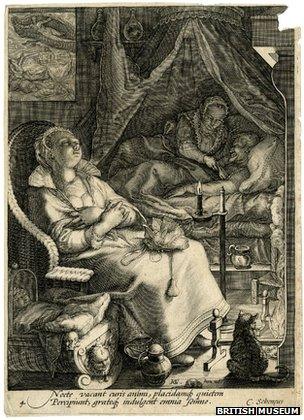(yeah I have to say heck and keep offensive content to a minimum
Segmented Sleep is the practice of what is arguably a natural human sleeping pattern consisting of two sleeping period divided by a wakeful period. . Historian A. Roger Ekirch argued that before the Industrial Revolution, segmented sleep could have been the dominant way that people slept in Western civilization/Culture. IT has also been argued to be an agent in stress relief.
"The existence of our sleeping twice per night was first uncovered by Roger Ekirch, professor of History at Virginia Tech.
His research found that we didn’t always sleep in one eight hour chunk. We used to sleep in two shorter periods, over a longer range of night. This range was about 12 hours long, and began with a sleep of three to four hours, wakefulness of two to three hours, then sleep again until morning.
References are scattered throughout literature, court documents, personal papers, and the ephemera of the past. What is surprising is not that people slept in two sessions, but that the concept was so incredibly common. Two-piece sleeping was the standard, accepted way to sleep." --The Sourced BBC articleAmazon has Ekirch’s book At Day’s Close: Night in Times Past by the way! I found that out hile perusing and it is rife with example of segmented sleep.
I heard about this little phemomenon a while back and finally got around to actually research it. It seems pretty legit. Scientists are starting to think that this may be our natural sleep cycle as well. Which to me would make sense because 1/3 of your day just sleeping...c'mon in a world of survival where there is no government to keep ya safe. It seems very anti-evolutionary. Ekirch credits this to modern electricity giving us that artificial light feeling. He did a study where people were deprived of light and most reverted back to their 1st sleep.2nd sleep cycle within a few weeks.
This is what wikipedia Also has in the 'Segmented Sleep' Entry
"The human circadian rhythm regulates the human sleep-wake cycle of wakefulness during the day and sleep at night. Ekirch suggests that it is due to the modern use of electric lighting that most modern humans do not practice segmented sleep, which is a concern for some scientists.[8] Superimposed on this basic rhythm is a secondary one of light sleep in the early afternoon and quiet wakefulness in the early morning.
The brain exhibits high levels of the pituitary hormone prolactin during the period of nighttime wakefulness, which may contribute to the feeling of peace that many people associate with it.[9] It is in many ways similar to the hypnagogic and hypnopompic states which occur just before falling asleep and upon waking, respectively." -Wikpedia
Much like the experience of Wehr's subjects, these references describe a first sleep which began about two hours after dusk, followed by waking period of one or two hours and then a second sleep. "It's not just the number of references - it is the way they refer to it, as if it was common knowledge," Ekirch says. During this waking period people were quite active. They often got up, went to the toilet or smoked tobacco and some even visited neighbours. Most people stayed in bed, read, wrote and often prayed. Countless prayer manuals from the late 15th Century offered special prayers for the hours in between sleeps. And these hours weren't entirely solitary - people often chatted to bed-fellows or had sex.
Between segments null Some people: Jog and take photographs Practise yoga Have dinner... Ten strange things people do at night A doctor's manual from 16th Century France even advised couples that the best time to conceive was not at the end of a long day's labour but "after the first sleep", when "they have more enjoyment" and "do it better". --The Sourced BBC article
Another Article on the subject



No comments:
Post a Comment